Black diamonds: How Spain became world's truffle capital
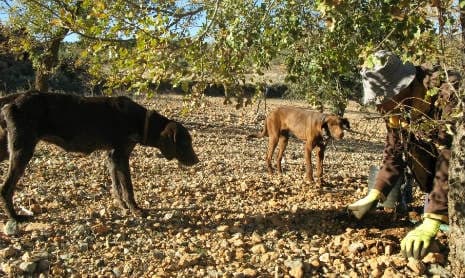
In a remote corner of eastern Spain the cultivation of pungent 'black diamonds' is transforming a rural economy and making the region the truffle capital of the world.
The dogs weave amongst the trees, their noses moving back and forth across the arid barren ground until they catch a whiff and excitedly start to paw the loose stone earth.
Their human companion stoops to his knees and using a dagger-shaped trowel carefully dislodges what appears to be a gnarled black nugget not much larger than a walnut. He lifts it to his nose and inhales its pungent earthy smell.
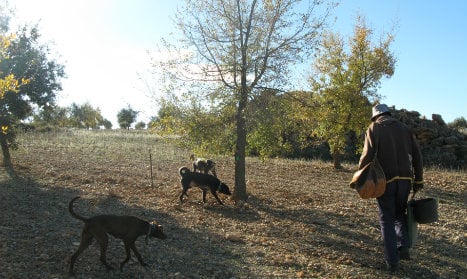
We are in the arid landscape of Gúdar Javalambre, one of the lesser known parts of Spain’s interior situated between the mountains of Teruel and the Valencian coast, and a region that has, remarkably, become the capital of the global truffle industry.
Since the 1980s swathes of hillsides in one of Europe's most sparsely populated regions - just 9,000 inhabitants live in some 24 towns and villages in the county - have been given over to plantations of holm oak trees, a species ideal to the cultivation of "black diamonds", the sought after culinary treasure that is almost worth its weight in gold.
Less valuable than the more famous wild white truffle of Italy's Piedmont, the black truffle (tuber melanosporum) is single-handedly responsible for the regeneration of a region that has suffered from depopulation and a lack of investment.
This year an estimated 40 tonnes, representing around 70 percent of the world’s truffles, will come from the Teruel region, where some 6,500 hectares in total are given over to cultivating the product.
"Truffles has been like winning the lottery for this town," explained Eladio Salvador Rédon, owner of a truffle plantation in the hills above Sarrión, where he oversees a cultivation process that involves spores of the fungus being applied to the roots of seedlings.
"Before cultivating started these fields were set aside for crops, but it is not fertile land. It’s stony, it’s dry, conditions are hard," he told The Local on a tour of his plantation.
"They say here that it is eight months of invierno (winter) followed by four months of inferno," he said with a dry laugh adding that the climate was perfect for truffles.
"After the Spanish Civil War people started to leave, there wasn’t work here and people migrated to the cities where there were more opportunities. It became a region of abandoned villages."
"But now people are coming back to live and work here. The truffle has kick started an entire economy."
And he’s right. At the annual truffle convention held in early December, dozens of stall holders have set out their wares and it is impossible to escape the earthy mushroomy aroma of the truffle wafting through the air.
From soap to hand cream, from chocolate to honey and from infused sea-salt to liquor, taking in every sort of cheese and embutido on the market, each and every product on sale has the addition of truffle.
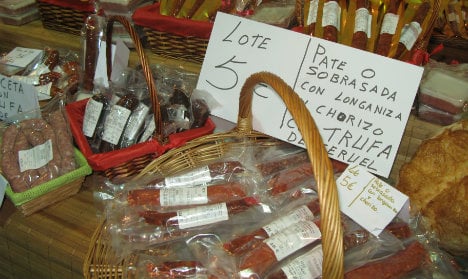
"There are so many products that can be enhanced with a little sprinkle of truffle," boasts one of the women behind the counter at the Manjares de la Tierra stall, where an array of pates and mousses are being offered.
The company is just one of the new businesses dedicated to promoting products containing the black diamond of the Teruel soil.
Hotels and restaurants in the region are cottoning on to the potential too, offering truffle themed packages that include weekend breaks and gourmet experiences where every dish contains truffles.
But extraordinarily, although highly sought after in French and Italian cuisine, a mere five percent of truffles cultivated in Spain are destined for the Spanish table.
Most are exported first to France and from there sold on to Italy, the UK and the United States where gourmands will most likely never discover that the shavings on the plate have their origins in Spain.
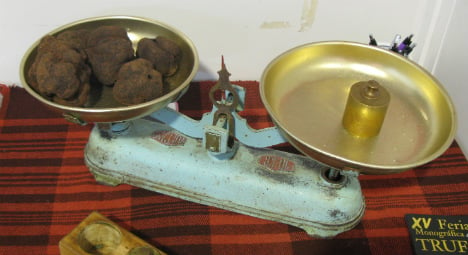
But that could all be about to change if truffle producers have their way.
"Our aim is to do more to promote truffles within Spain, to spread the word about the different ways to use truffles and of course to promote it abroad as a Spanish brand," explained José Manuel Martínez Matías from Atruter, the association that represents the area’s truffle growers.
And there are calls to make the market more regulated.
At present truffles are sold to dealers at a bizarre gathering in the local railway station carpark held in the dark every Saturday night of the November to March season.
The dealers, who have often driven all the way France, furtively examine the wares on offer by torchlight in the back of the car before making an offer based on quality and size.
The price tag for the truffle is currently high as both France and Italy are suffering a bad season.
For Rafael Doñate, one of four brothers who run one of Sarrión’s most successful truffle cultivation companies, it is essential to build the Teruel brand so that the truffles grown here get the recognition they deserve.
At the truffle fair in Sarrión he proudly holds out a perfect specimen.
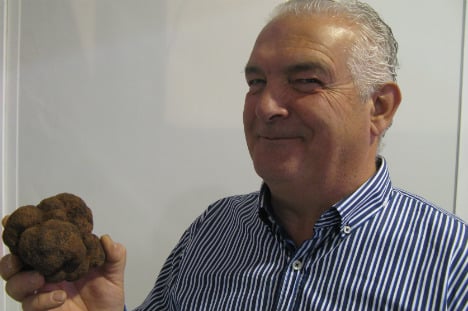
With its crinkled black exterior and pungent earthy smell, the fist sized truffle which weighs in at 350 grams has a price tag of €295 ($322).
"If like this one it is a top quality truffle with no blemishes then at the moment it goes for €850 a kilo," explained Doñate. "But the price fluctuates".
"This funny looking lump is the black treasure hidden in the roots of our trees that is bringing us salvation and now we just need to find a way to tell the world."
READ ALSO: Why wine lovers should make the Spanish city of Teruel their next destination
Comments
See Also
The dogs weave amongst the trees, their noses moving back and forth across the arid barren ground until they catch a whiff and excitedly start to paw the loose stone earth.
Their human companion stoops to his knees and using a dagger-shaped trowel carefully dislodges what appears to be a gnarled black nugget not much larger than a walnut. He lifts it to his nose and inhales its pungent earthy smell.

We are in the arid landscape of Gúdar Javalambre, one of the lesser known parts of Spain’s interior situated between the mountains of Teruel and the Valencian coast, and a region that has, remarkably, become the capital of the global truffle industry.
Since the 1980s swathes of hillsides in one of Europe's most sparsely populated regions - just 9,000 inhabitants live in some 24 towns and villages in the county - have been given over to plantations of holm oak trees, a species ideal to the cultivation of "black diamonds", the sought after culinary treasure that is almost worth its weight in gold.
Less valuable than the more famous wild white truffle of Italy's Piedmont, the black truffle (tuber melanosporum) is single-handedly responsible for the regeneration of a region that has suffered from depopulation and a lack of investment.
This year an estimated 40 tonnes, representing around 70 percent of the world’s truffles, will come from the Teruel region, where some 6,500 hectares in total are given over to cultivating the product.
"Truffles has been like winning the lottery for this town," explained Eladio Salvador Rédon, owner of a truffle plantation in the hills above Sarrión, where he oversees a cultivation process that involves spores of the fungus being applied to the roots of seedlings.
"Before cultivating started these fields were set aside for crops, but it is not fertile land. It’s stony, it’s dry, conditions are hard," he told The Local on a tour of his plantation.
"They say here that it is eight months of invierno (winter) followed by four months of inferno," he said with a dry laugh adding that the climate was perfect for truffles.
"After the Spanish Civil War people started to leave, there wasn’t work here and people migrated to the cities where there were more opportunities. It became a region of abandoned villages."
"But now people are coming back to live and work here. The truffle has kick started an entire economy."
And he’s right. At the annual truffle convention held in early December, dozens of stall holders have set out their wares and it is impossible to escape the earthy mushroomy aroma of the truffle wafting through the air.
From soap to hand cream, from chocolate to honey and from infused sea-salt to liquor, taking in every sort of cheese and embutido on the market, each and every product on sale has the addition of truffle.

"There are so many products that can be enhanced with a little sprinkle of truffle," boasts one of the women behind the counter at the Manjares de la Tierra stall, where an array of pates and mousses are being offered.
The company is just one of the new businesses dedicated to promoting products containing the black diamond of the Teruel soil.
Hotels and restaurants in the region are cottoning on to the potential too, offering truffle themed packages that include weekend breaks and gourmet experiences where every dish contains truffles.
But extraordinarily, although highly sought after in French and Italian cuisine, a mere five percent of truffles cultivated in Spain are destined for the Spanish table.
Most are exported first to France and from there sold on to Italy, the UK and the United States where gourmands will most likely never discover that the shavings on the plate have their origins in Spain.

But that could all be about to change if truffle producers have their way.
"Our aim is to do more to promote truffles within Spain, to spread the word about the different ways to use truffles and of course to promote it abroad as a Spanish brand," explained José Manuel Martínez Matías from Atruter, the association that represents the area’s truffle growers.
And there are calls to make the market more regulated.
At present truffles are sold to dealers at a bizarre gathering in the local railway station carpark held in the dark every Saturday night of the November to March season.
The dealers, who have often driven all the way France, furtively examine the wares on offer by torchlight in the back of the car before making an offer based on quality and size.
The price tag for the truffle is currently high as both France and Italy are suffering a bad season.
For Rafael Doñate, one of four brothers who run one of Sarrión’s most successful truffle cultivation companies, it is essential to build the Teruel brand so that the truffles grown here get the recognition they deserve.
At the truffle fair in Sarrión he proudly holds out a perfect specimen.

With its crinkled black exterior and pungent earthy smell, the fist sized truffle which weighs in at 350 grams has a price tag of €295 ($322).
"If like this one it is a top quality truffle with no blemishes then at the moment it goes for €850 a kilo," explained Doñate. "But the price fluctuates".
"This funny looking lump is the black treasure hidden in the roots of our trees that is bringing us salvation and now we just need to find a way to tell the world."
READ ALSO: Why wine lovers should make the Spanish city of Teruel their next destination
Join the conversation in our comments section below. Share your own views and experience and if you have a question or suggestion for our journalists then email us at [email protected].
Please keep comments civil, constructive and on topic – and make sure to read our terms of use before getting involved.
Please log in here to leave a comment.